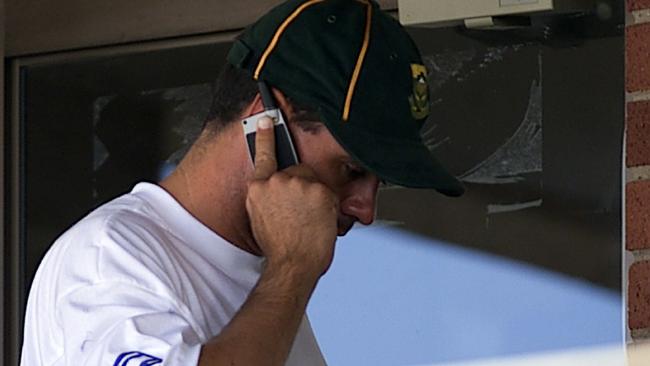
It is the only Test England have played in that was fixed — at least the only one that we know about — and it marked the end of innocence, given that the scale and scope of the corruption throughout international cricket in the 1990s was laid bare within months of its conclusion.
In retrospect, the match between England and South Africa at Centurion from January 14 to 18, 2000, was ripe for attention from bookmakers.
The series had been won by South Africa, and the final match was a dead rubber; rain that wiped out days two, three and four meant there was a huge liability on the draw and, although we did not know it then, the bookmakers already had their claws into one of the captains, Hansie Cronje.
A South African gambler called Marlon Aronstam contacted Cronje on the fourth evening with a petty inducement to ensure the match was not drawn, and it was after the rains relented on the morning of the fifth day that negotiations began for both sides to forfeit an innings and set up an England run-chase — ostensibly under the ruse, suggested by Cronje, that any run-chase would be good for spectators who had endured a miserable three days.
When I write that the game signalled the end of innocence, it is because no one in the England team gave any thought to corruption when Cronje suggested the final-day arrangements. Certainly not his opposite number, Nasser Hussain, and certainly not me, when I unwittingly became part of the nonsense having been sent off the field during play on the fifth morning to conduct negotiations for the runs/overs equation on our behalf. Although it seemed out of character for the hitherto conservative South Africa captain, nobody had any suspicions as to his real motive.
In the years after that Centurion match, and the subsequent revelations of how embedded bookmakers were within the game, any unusual development, odd result or startling piece of fielding — a simple dropped catch, for example — would always carry suspicion. That, of course, is the curse of match-fixing (or doping), as it robs viewers of their innocence and adds a dash of cynicism to the spectator experience.
Can we really believe what we are seeing? So it was that the only Test win as a player for Chris Silverwood, now the England head coach, came to have an asterisk next to its name. Three months later, on April 7, at the start of the domestic English season, came tapes, recorded by the Delhi police, of Cronje talking to Indian bookmakers, followed by an initial denial, then a confession and then the King Commission, two months after that, during which Cronje’s four-year involvement with the subcontinent bookmakers, and the nature of his deceit, was laid bare.
After initially defending its captain when the news broke, Cricket South Africa had a clear policy during the King Commission. Its reasoning was that if the bookies could get to a man like Cronje, it would be highly unlikely that he would be the only player brought under their influence. Its intuition was correct.
Ali Bacher, the managing director of Cricket South Africa at the time, said: “It was highly improbable that only one person was involved and that this was surely a global problem … unless we exposed that, nothing good would come from the commission.”
As information dripped out, the ramifications were profound. The first anti-corruption unit was set up under Sir Paul Condon, later Lord Condon, and a root-and-branch review of corruption in cricket undertaken.
The influence of that game continues to be felt today. The ICC’s Anti-Corruption Unit has more investigative powers than ever before; it is more active than it has ever been, targeting not only cricketers but the potential corruptors too, and those on the fringes of the game.
The media, too, is more proactive and alert to corruption than it was: the most significant match-fixing episode of the past 10 years came as a result of a newspaper sting, and Al Jazeera did a pair of undercover documentaries two years ago which, it must be said, generated more heat than light.
The combination of both those things — the extent of anti-corruption powers and general awareness and reporting of the problem — means that the landscape has significantly altered. On the eve of the infamous Centurion match, the reporting of corruption and its incidence was inversely in proportion to now: back then the game was institutionally corrupt but the murky waters beneath were hidden from public view; now there is a lot of noise about corruption but the international game is, by and large, clean.
I can’t know for sure, of course, that the international game is largely clean. But a combination of experience, instinct and common sense says it is. Why attempt to corrupt games that are well policed and played by cricketers earning large amounts of money, when you can go after low-hanging fruit — players who are less well paid in games that are less well policed with the advantage that they are televised and therefore fair game? A gamble that pays off is a gamble that pays off, no matter the status of the match.
For different reasons, there is far more noise around corruption than there was, and that can be distorting, giving the impression that the game is more rotten than it is. For example, the ACU’s scope has significantly broadened, so that players can be carpeted for failing to report an approach; the ACU is far more open than before, and there is far more cricket for corruptors to go at, in murky corners where the ACU’s tentacles cannot spread.
Recent examples of the ACU’s work include action against an administrator, a groundsman, a selector, and various players from associate nations.
The greater incidence of corruption in domestic franchised cricket compared with international cricket remains the best hope for the hegemony of the international game. Those domestic leagues have a lot going for them for the most part — it is easier for teams who can import and buy players to retain a competitive edge, whereas international cricket has fixed boundaries for talent and is limited by the small number of teams who play at the highest level — but they are much less well policed and therefore much more vulnerable to corruption.
That is why that match at Centurion remains significant as far as the international game is concerned. It resulted eventually in the can of worms being opened and measures taken to clean up the game. It resulted in a permanent drop of cynicism that should keep custodians on their toes.
With as much confidence as I can muster, and aware of the potential criticism of complacency that will come my way, I am convinced that the Test you are about to watch at St George’s Park, Port Elizabeth, as well as the vast majority of other international cricket, is above board and free from corruption.
The Times




Today marks the 20th anniversary of the start of one of the most unusual and — in its tragic way — significant Test matches in which I played.